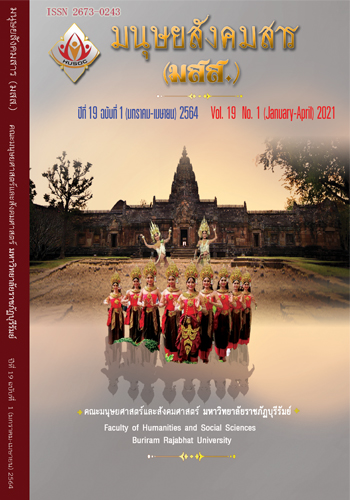Tourism Village and Learning Center : A Case Student of Packaging Design of Sugarcane Juice of Saiyao Community
Main Article Content
Abstract
The purposes of this research study are: 1) to explore the origin of sugarcane product and analyze the need for sugarcane juice packages of Sai Yao Tourism Village and Community Learning Center 2) to design the package of sugarcane juice of Sai Yao Tourism Village and Community Learning Center. The study reveals that the people of Sai Yao Community have learned sugarcane plantation from their ancestors. The most popular variety of sugarcane grown is K95, making it suitable for juice extraction. In the past, wooden rollers were popular for sugarcane crushing. The rollers were rotated by the force of cows or buffaloes to turn the sugarcane into fresh sugarcane juice . With regard to the need for sugarcane juice package, the researcher has determined the content for designing five package drafts. The logo is designed under the brand of Chao Rai. Graphics on the package reflect the wisdoms of sugarcane farming and original way of sugarcane crushing. Results of an evaluation of satisfaction of three design experts show that the second design draft has the highest average () of 4.67 and standard deviation (S.D.) of 0.58, and thus is the most suitable to make the prototype package.
Article Details

This work is licensed under a Creative Commons Attribution-NonCommercial 4.0 International License.
เนื้อหาและข้อมูลในบทความที่ลงตีพิมพ์ในวารสารทดสอบระบบ ThaiJo2 ถือเป็นข้อคิดเห็นและความรับผิดชอบของผู้เขียนบทความโดยตรงซึ่งกองบรรณาธิการวารสาร ไม่จำเป็นต้องเห็นด้วย หรือร่วมรับผิดชอบใดๆ
บทความ ข้อมูล เนื้อหา รูปภาพ ฯลฯ ที่ได้รับการตีพิมพ์ในวารสารทดสอบระบบ ThaiJo2 ถือเป็นลิขสิทธิ์ของวารสารทดสอบระบบ ThaiJo2 หากบุคคลหรือหน่วยงานใดต้องการนำทั้งหมดหรือส่วนหนึ่งส่วนใดไปเผยแพร่ต่อหรือเพื่อกระทำการใดๆ จะต้องได้รับอนุญาตเป็นลายลักอักษรจากวารสารทดสอบระบบ ThaiJo2 ก่อนเท่านั้น
References
Bhupetch, W. (16 May 2019). Technical officer of pilot self-sufficiency economy learning center of Sai Yao community. Non Samran village, Thalung Lek sub-district, Muang district, Buriram province. Interview. [in Thai]
Chinawong, K. (2016). Sai Yao: A community of weavers, life capital and culture (1st ed.). Chiang Mai: Wanida Printing. [in Thai]
Daosomboon, J. & M, Pennapa. (2015). A guideline for designing graphics on packages to convey the flavors and appearance of honey product of young farmers group of Choomyang village, Thapthan district, Uthai Thani province. Journal of Industrial Education, 14(3), 467. [in Thai]
Gnernthai, P. (2018). Visiting Non Samran village, Thalung Lek sub-district, Muang district, Buriram province. [Pamphet]. Buriram: Agricultural Productivity Efficiency Increasing Learning Center. [in Thai]
Gnernthai, P.. (27 April 2019). President of the agricultural productivity efficiency increasing learning center. Non Samran village, Thalung Lek sub-district, Muang district, Buriram province. Interview. [in Thai]
Nachaisin, D. (2015). Basic knowledge of packaging design (1st ed.). Khon Kaen: Khon Kaen University Printing House. [in Thai]
Nantachai, K. (1997). Sensory perception of consumers towards Juice of different sugarcane varieties. KKU Research Journal, 2(1), 10. [in Thai]
R. Kaavya & R. Pandiselvam. (2019). Sugarcane juice preservation: A critical review of the state of the art and way forward. An International Journal of Sugar Crops and Related Industries Sugar Tech, 21(1), pp 9 -19.
Sawasdee, P. (2016). Sai Yao: A community of weavers, life capital and culture (1st ed.). Chiang Mai: Wanida Printing. [in Thai]
Thitawan, N. (2018). Packaging design trends for 2019. Retrieved on 15 March 2018 from https://lab.sal.mn/2018/12/packaging-trend-2019/61022/
Wanthana, T. (1996). Juice cane: Suphan Buri field crops research center. Retrieved on 22 September 1996 from http://www.geocities.com./Research Triangle/Lab/2419/THAI12.HTML.
Yuensukthanang, D. (21 January 2019). President of pilot self-sufficiency economy learning center of Sai Yao community, Non Samran village, Thalung Lek sub-district, Muang district, Buriram province. Interview.


